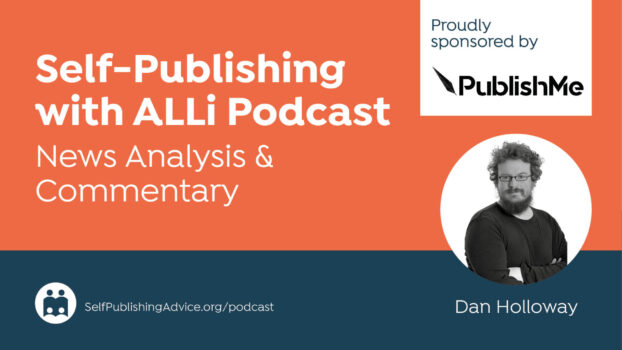
Watch your fan base grow
Reader subscriptions can be a great way to connect with your fans, generate revenue and cultivate a loyal following. By offering exclusive content, personalized interactions or behind-the-scenes access, authors can create a sustainable income stream while strengthening reader relationships. In today’s post, we'll delve into the essentials of establishing and running a subscription programmes, exploring key models, tools and best practice to maximize success, so you can watch your fanbase flourish.
Understanding the subscription model
At its core, a subscription-based model involves offering readers ongoing access to exclusive content beyond your traditional books in exchange for a recurring fee. It can be seen as part of the ‘creator economy’ – the ways in which consumers can directly support us to keep providing creative work to our readers.
Subscription offers can be as varied as you can imagine and some authors pull together a combination of several different models, but we’ve included six subscription models below to get you started. These grow in complexity from placing your content on third party subscription platforms, right up to the full serialisation model (and if this floats your boat, look out for an author case study late in this post):
1. Third-Party Subscription Platforms
Using existing subscription platforms (otherwise known as ‘discovery’ platforms) is a little different to utilising other subscription models. Rather than offering access to you or exclusive content, these platforms offer access to your books through subscriptions that readers pay directly to the platform itself. Part of the fee is then passed on to you should they choose your book. However, we felt they were important to include in this post, as these platforms often appeal to enthusiastic readers who read several books a week or month and will often be quite a different audience to those who pick up books on your other platforms or in store. They are worth considering if you feel running your own subscription service may be too time consuming for you, or if you are interested in reaching very wide and making your books as discoverable as possible.
Look for subscription sites that make the most sense for your genre or niche. Some sites to check out would include, for ebooks: Bookmate, Kobo Plus, 24symbols. Or for Audiobooks: Audible, or AudioBooks.com. Scribd or Storytel are also options for both audio and ebooks. Remember to check the exclusivity rules on any site you sign up to, and if you use any third-party subscription service you cannot then use KU on Amazon or any other exclusive platform.
 2. Paid Newsletter Subscriptions:
2. Paid Newsletter Subscriptions:
At its simplest level, a premium paid-for newsletters subscription is a method of offering regular bonus content, exclusive author updates, and special offers to subscribers which land straight in their mail-boxes. Utilize email marketing software like Substack or Mailchimp (many other optoins are available) to create and distribute exclusive content only available to your premium newsletter subscribers. Payments can be either made directly to you through your own site before you add the subscriber to your mail-list, or through the platform provider.
This option is usually priced at the lower end of a subscription model but can suit authors who don’t have the time (or potentially digital skills) to manage a forum or more complex platform, but who would like to offer their biggest fans additional content beyond the usual newsletter updates. Make sure you have set aside time to produce the content and keep up with the regularity promised to your subscribers. You may want to produce the ongoing content up front to it is ready to send out each week on time, every time. Set a schedule, such as weekly excerpt emails and a monthly video. Subscribers should look forward to opening your email and finding out what you are sharing each week.
3. Closed Online Communities:
Creating a private forum or similar, such as a Discord service, offers subscribers the chance to engage with you, the author, and fellow fans in a shared space on a regular basis. This approach can be particularly successful for authors writing about complex narratives or universes that inspire readers to discuss and explore characters, locations and themes in depth outside of the books themselves. More often this works for non-fiction writers, where communities can meet regularly to discuss how-to skills, motivate one another to fix problems or share struggles and successes together. You could even see ALLi itself fitting into this subscription model, with our own SelfPubConnect for Members as the online community space. If you choose an online community for your subscription model, consider regular live Q&As with you, or experts in your niche, and fan events such as discussions, quizzes, giveaways and readings.
4. Membership Platform (providers):
Platforms like Patreon or Substack allow authors to offer membership levels and host a range of exclusive content easily, with members paying a fee to access the content or select other perks for their monthly fee. These can include the weird and wonderful too, such as personal shout outs on podcasts. The best way to explore different options offered by authors is to take a look on the platforms themselves to see what authors in your niche are offering. For example, friend of ALLi, Joanna Penn has a Patreon Membership service and you can take a look at her membership options for inspiration without needing to sign up, here: Membership Examples for Patreon Subscriptions.
What is unique to these platforms, most famously Patreon, is that they can also be used to fund the production of your books before they are produced, with readers becoming patrons of your work. Fans offer direct donations to fund your writing in exchange for specific offers once the book is complete. This can also be known as a crowdfunding or running a ‘kickstarter' and is different to, but related to, the subscription model. To find out lots more about this process, take a listen to ALLi Director Orna Ross on this recent podcast: Why Kickstarter is the Most Creative Way to Launch Your Book.
5. Membership Platform (your own):
More authors are now looking to use an area of their own website as a closed space for members to log in to and access exclusive content or communicate with you as the author; just as selling direct through an author website is also growing. Benefits of this approach is managing all your own activity in one place, keeping ownership of your content close, and ensuring if any issues take place with third party platforms, you are not affected. Payments can be made through plugins and most websites have a log-in function. You can then offer exclusive content, such as downloads of book excerpts, or video Q&As, in the ‘Member’ area of your website, managing everything in one place easily.
6. Book Serialisation:
This model builds on the success of free story-sharing websites such as Wattpad, which has fostered many a self-published author’s success in the past. Here, the model calls for readers to pay a fee to receive the next instalment in the story on a regular basis, building anticipation and value for the reader as they receive each section on a regular basis. Note that some authors have such enthusiastic followers that even rough drafts of upcoming chapters released early can draw a fee, and you can find out much more about how this works in the real-world with a case study from Emilia Rose later in this post.
Crafting compelling content
Central to the success of any subscription for authors project is the creation of compelling, high-quality content that resonates with your audience and is released regularly through your chosen platform. The content you produce will depend on your books and brand, but a few options to consider include:
- Exclusive stories or excerpts: Provide subscribers with access to exclusive short stories, bonus chapters, additional tips and advice, or excerpts not available elsewhere.
- Early access: As Emilia Rose will show below, early access to content before other readers can be a big draw for your most enthusiastic fans, even rough drafts can be monetized.
- Behind-the-scenes access: Offer behind-the-scenes glimpses into your writing process, including research insights, character sketches, cover options, and drafts.
- Interactive experiences: Engage subscribers through live Q&A sessions, virtual book clubs, or interactive storytelling events. You may even want to consider face-to-face access if you attend conventions or book fairs.
- Personalized content: Tailor content to the interests and preferences of your subscribers, fostering a sense of community and connection.
How do you build your subscriber audience?
Building a loyal subscriber base requires proactive engagement. Start off with your own channels, utilizing social media, author newsletters, book end matter, and launch events to promote your subscription offering and encourage sign-ups.
Providing incentives can make the difference as to whether people join or not, for example offering early access to your next new release, exclusive discounts, or personalized shoutouts to the next ten people to sign up to your subscription service.
Plan how you will cultivate a sense of community among subscribers right from the start. How often will you communicate with your community or send a newsletter? Make sure this is transparent up front. If you have a forum, encourage interaction, facilitate discussions, and acknowledge contributions from your readers regularly, and that means every day if possible. Readers will appreciate even the smallest update and contact with you regarding your work. In some platforms you can pre-set some interactions, although ideally you want to interact live to maintain authenticity.
Explore platforms like Zoom or Discord for hosting virtual events such as live Q&A sessions, author readings, and interactive workshops, as direct contact with you can be the best way to inspire sign ups. But make sure you have a good understanding of where your readers are so that you are hosting at a time that suits as many people as possible. This can be seen through the analytics on the platform you are using. Most platforms will have free tutorials to explain how to use analytics to understand your users, including where they are, how they are engaging, and when. This is important to track performance metrics, and gather audience insights.

Photo by micheile dot com on Unsplash
Monetization strategies and pricing
When determining pricing for your subscription, try to strike a balance between affordability and value. Here are some further details to consider:
- Monthly or Annual Regular Payments: Using an integrated payment system on your own website or through a platform you have selected can be a quick way to set up an ongoing monthly or annual payment for your subscribers to sign up to if you are offering one simple regular subscription for all.
- Tiered Pricing: You can also offer multiple subscription tiers with varying levels of access and benefits. This ensures you can cater to different audience segments and budget preferences. This is ideal if you are using a platform which will manage the tiered levels for you.
- Early Bird Discounts: Provide discounted pricing or exclusive perks for early adopters can incentivize sign-ups and generate initial momentum.
- Special Offers and Promotions: You can periodically offer special promotions, seasonal discounts, or limited-time offers to attract new subscribers and retain existing ones.
- Diversified Revenue Streams: Supplement subscription revenue with additional income streams such as merchandise sales, affiliate partnerships, or sponsored content collaborations, for example with authors in the same genre as you.
Nurturing long-term relationships with your subscribers
Beyond acquiring new subscribers, fostering loyalty is essential for the sustained success of your subscription service, so listening to feedback at the start is critical. Ask early subscribers how the experience is going in the first few weeks and months. Actively incorporate their suggestions and preferences to ensure they stay and that they encourage others to join.
Consider how to regularly recognize and reward loyal subscribers with exclusive perks, personalized acknowledgments, or special events to demonstrate appreciation for their support. Perhaps you can run a shout-out every month to those who have been with you for a particular period of time?
Above all, stay agile and adaptable. Keep up to date with what’s happening in the author subscription world and learn from what’s working, particularly if technology changes. You want your subscribers to look forward to logging in and visiting your space, or opening your content and interacting with you. So, ensure it always stays a welcoming, surprising and positive place to be.

Emilia Rose
Case study: Emilia Rose
With millions of online story views on serial fiction platforms, Emilia Rose is a USA Today bestselling author of steamy romance. She lives in a small town in Connecticut USA with her husband, cats, and a couple of cute yellow ducklings. To find out more about Emilia, visit her website. Here is her story of building her subscription fanbase, first shared with ALLi in 2022:
In January 2019, I began publishing my first story under Emilia Rose on Wattpad, a serial fiction platform where authors share their stories for free and readers are hungry for new books.
Subscriptions or memberships give me more freedom to write what I want, not what is hot on Amazon right now. I don’t have to write a book a month in order to please the Amazon gods and don’t have to rely on KU reads. There’s nothing wrong with KU—if that’s for you—but I don’t particularly like having all my books in one place. I want as many readers to pick up my book as possible and I don’t have to worry that one day Amazon will shut me down because I write steamy content.
Additionally, through my subscription, my fans join the creative process with me. They comment and provide feedback on scenes that I’m unsure about and are amazing beta readers! They love giving me suggestions, and I find that it helps foster community. I poll them about almost everything and have asked them for help on stories, merch designs, audiobook narrators, and more. And I really listen to their feedback. If something isn’t working for them, it probably won’t work when I release it through wide retailers. So, I utilize their comments and pivot where I need.
From this process, my membership brings in a stable five-figure income each month.
So, what really is early access? Do I edit the books before I post them? What about outlining? How does this even work?!
Early access is access to my book before its published on wide retailers and before its published for free on Wattpad. I write a good chunk of the book—or sometimes the entire book—through my subscription, then release one to two chapters per week onto free reading platforms like Wattpad or through my newsletter. From there, I will direct people (who want to read more of the story right away) to my membership. If they want to read the chapters now, they join. If they want to wait, they read a new chapter for free every week.
My main advertising is through free platforms like Wattpad. I have been reading and writing werewolf romance on Wattpad for years before I even started my subscription. While I post one chapter for free on Wattpad, then direct the users to get early access to the remainder of the story through my membership, I still make sure I finish the story on Wattpad for free. For me, this is essential for building relationships with readers.
I also have funnels through my newsletter, using the same flow. I will release one chapter per week to my serial fiction newsletter subscribers, then have a button that leads to my membership to read the rest of the story right now. Again, the story does get finished through my newsletter for free, so subscribers can potentially read it all without paying anything if they want to wait.
But everyone who is a subscription member of mine receives weekly chapters of my rough drafts. Yes, people pay to read my rough drafts. It’s really crazy to think about, because everyone believes that readers won’t pay for books that aren’t the final edited and polished versions. It took me a long time to wrap my head around it too. But I’ve found that my readers just want more of my writing and they will read a rough version of a story.
My advice to anyone thinking about starting a subscription is to have patience. Unless you’re new to publishing, you’ve trained readers for a long, long, long time to purchase your book on wide retailers or read for free in KU. It will take time to re-train them to join your subscription. So, if it doesn’t work at first, don’t give up! Some genres are slower to join subscriptions while other genres like steamy romance and litRPG are quick moving toward subscriptions. But that doesn’t mean subscriptions won’t work for you if you’re in a completely different genre.
With thanks to Emilia Rose for sharing her story – you can find out more about her current subscription on her Ream subscription page.
Conclusion
Running a subscription model for your author business presents a unique opportunity for writers to connect with readers on a deeper level, generate a sustainable income, and cultivate a dedicated fanbase. If you take this step, focus on crafting compelling content, engaging your audience effectively and using the right technology to help you nurture long-term relationships with your readers.
Find out more





